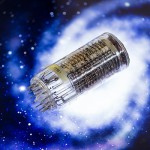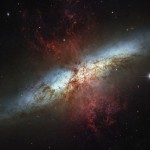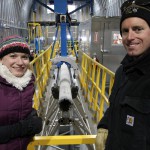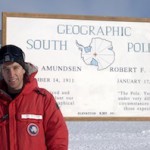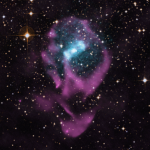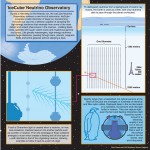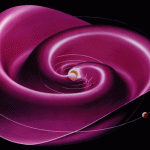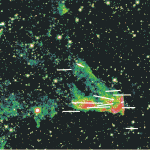Tag Space & astronomy
Letting off steam: Gas discharge terminates galaxy’s star formation
With the help of a radio telescope in the French Alps, an international team of astronomers, including two from the University of Wisconsin–Madison, has observed a never-before-seen stage of galactic evolution. Writing in this week’s Nature, a group that includes UW–Madison astronomers Aleks Diamond-Stanic and Christy Tremonti, reports measurements of dense, cold hydrogen gas being blasted from a distant star-forming galaxy, the first direct observation of the “blow out” phase of a galaxy’s evolution.
Telescopes hint at neutrino beacon at the heart of the Milky Way
Thanks to a confluence of data from a suite of vastly different telescopes, there are tantalizing clues that the massive black hole at the core of the Milky Way may be a cosmic accelerator. In a recent paper published in the journal Physical Review D, a team led by University of Wisconsin–Madison physicist Yang Bai reports a correlation of IceCube data with a recorded burst of X-rays from Sagittarius A, an object at the center of our galaxy that is believed to be a supermassive black hole.
Satellite history at UW–Madison comes full circle with award
Michael Pavolonis thinks of himself as a volcano guy.
UW team’s plants return to Earth after growing in space
Researchers at Simon Gilroy's lab in the Department of Botany at the University of Wisconsin–Madison expect to greet a truck this afternoon that is carrying small containers holding more than 1,000 frozen plants that germinated and grew aboard the International Space Station.
They know the drill: UW leads the league in boring through ice sheets
Hollow coring drills designed and managed by UW–Madison’s Ice Drilling Design and Operations (IDDO) program are used to extract ice cores that can analyze the past atmosphere. Shaun Marcott, an assistant professor of geoscience at UW–Madison, was the first author of a paper published today in the journal Nature documenting carbon dioxide in the atmosphere between 23,000 and 9,000 years ago, based on data from an 11,000-foot hole in Antarctica.
UW-Madison becomes newest Intel Parallel Computing Center
The University of Wisconsin–Madison has been selected to join the Intel Parallel Computing Centers program.
Beginning of time to unfold at UW–Madison Space Place
Eavesdrop on the beginning of time this Friday evening (May 30, 2014) at the University of Wisconsin–Madison's Space Place, 2300 S. Park St.
Video: Uncommon unrainbow brings dash of color to sky
It’s a rainbow. It’s a sun dog. No, it’s a fire rainbow, which isn’t actually a rainbow at all.
New Milky Way portrait to be on Town Center media wall
The dramatic new infrared picture of the plane of our galaxy will be viewable for the next week on the large media wall in the Town Center of the Wisconsin Institutes for Discovery on the UW–Madison campus.
Nathan Whitehorn a 2014 ‘Young Star’ in astrophysics
Nathan Whitehorn, a postdoctoral researcher on the IceCube project at the University of Wisconsin–Madison, has been named a “Young Star” by the Division of Astrophysics of the American Physical Society (APS).
Fledgling supernova remnant reveals neutron star’s secrets
With the help of NASA’s Chandra X-ray Observatory and the Australia Telescope Compact Array, an international team of astronomers has identified the glowing wreck of a star that exploded a mere 2,500 years ago — the blink of an eye in astronomical terms.
IceCube pushes neutrinos to the forefront of astronomy
The IceCube Neutrino Observatory, a particle detector buried in the Antarctic ice, is a demonstration of the power of the human passion for discovery, where scientific ingenuity meets technological innovation.
IceCube feature film to premiere in Milwaukee planetarium show
The IceCube Neutrino Observatory is one of a kind. Built deep within the Antarctic ice, it is the world’s largest neutrino detector. Now, thanks to a collaboration between the Wisconsin IceCube Particle Astrophysics Center (WIPAC) and the Milwaukee Public Museum, it boasts another unique aspect: its own planetarium show.
Astronaut scholarship honors undergrad’s adventures in research
Even in the University of Wisconsin–Madison College of Engineering, where undergraduates are encouraged to seek hands-on experience, it’s rare that a faculty member finds himself taken aback by a freshman’s eagerness to get involved in research.
The sun also flips: 11-year solar cycle wimpy, but peaking
In a 3-meter diameter hollow aluminum sphere, Cary Forest, a University of Wisconsin–Madison physics professor, is stirring and heating plasmas to 500,000 degrees Fahrenheit to experimentally mimic the magnetic field-inducing cosmic dynamos at the heart of planets, stars and other celestial bodies.
Exhibiting signs of life
What if you could travel back in time 3 billion years, and take a breath? What would earth’s air smell like? Deeply stinky, according to Brooke Norsted, an outreach specialist for the University of Wisconsin–Madison Geology Museum.
Observations reveal critical interplay of interstellar dust, hydrogen
For astrophysicists, the interplay of hydrogen - the most common molecule in the universe - and the vast clouds of dust that fill the voids of interstellar space has been an intractable puzzle of stellar evolution.

